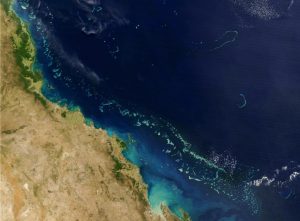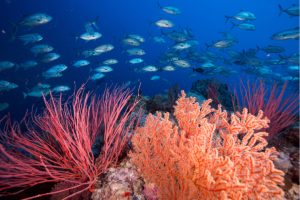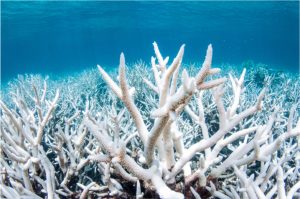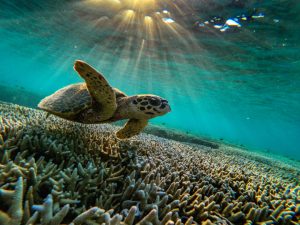When the British explorer James Cook (November 7, 1728 – February 14, 1779) embarked on his first scientific expedition, he took with him an assignment from the Royal Society—to observe from Tahiti the transit of Venus across the Sun—and a confidential mission from the British Admiralty—to search the South Pacific for any signs of the Terra Australis Incognita (unknown southern land) believed by the Royal Society to exist.
After observing the astronomical transit, the HMS Endeavour, captained by Cook, sailed westwards, where it ran aground on the Great Barrier Reef on June 11, 1770. The crew spent more than six weeks repairing the ship on a nearby beach at the mouth of a river—which Cook named Endeavour—where they made contact with Aboriginal people, who had known about this natural wonder for centuries.
Beloved by Australians, the reef complex—whose origins date back to the Miocene epoch— faces significant threats to its survival and the species that inhabit it.
FROM THE MIOCENE TO EUROPEAN EXPLORERS
“A reef such a one as I now speak of is a thing scarcely known in Europe or indeed anywhere but in these seas: it is a wall of coral rock rising almost perpendicularly out of the unfathomable ocean,” wrote Joseph Banks, one of the botanists on Cook’s expedition, obviously impressed.

His description was very accurate. This immense natural belt is formed by about two thousand reefs and nearly one thousand islands. Its extent covers more than 344,000 square kilometres, to the northeast of Australia, and is composed of living coral that grows on dead coral. It is precisely this lifeless colonial animal that makes up the great walls of coral rock that Banks referred to, which in some places measure up to one hundred metres in height.
The first reefs date back to the Miocene epoch, some 23 million years ago, when they began to grow on the Marion Plateau. Over the years they expanded, were born, grew and died. About 20,000 years ago, when the coast of Queensland (Australia) was located very close to the outer edge of the reef, Aboriginal people had contact with it and the thousands of creatures that inhabited it, including sponges, fish, worms, starfish, turtles, molluscs and crustaceans.

Cook was not the first European to discover the marine enclave. The Portuguese appear to have been there in the 16th or 17th century, but the British expedition was the first to describe it scientifically and bring it to the attention of European researchers, including Charles Darwin. Although the British naturalist did not observe the reef from the Beagle, he wrote about it thanks to the texts of other explorers.
BLEACHING, ITS GREAT THREAT
Despite being protected by UNESCO and the Great Barrier Reef Marine Park Authority, the reef is in danger. The culprit is rising temperatures caused by climate change. As the water warms, the single-celled zooxanthellae algae that live inside the polyps begin to produce oxidising molecules that are toxic to the coral, so the coral expels them. As the coral loses the photosynthetic algae that give it colour, it bleaches. This does not kill the coral directly, but it weakens it and makes it more susceptible to disease and nutrient deprivation, which will eventually kill it.

According to Chris Roelfsema, a researcher at the University of Queensland (Australia) and director of the 3D Great Barrier Reef Habitat Mapping Project, bleaching is the biggest threat to the coral reef and is the most difficult to control because of change climate. “The waters around the corals have increased their temperature more than normal,” he explains to OpenMind.
According to the Great Barrier Reef Foundation, Australian reefs have suffered at least six such major episodes since 1998, the most recent in 2022. This last episode, in which bleaching was observed in 91% of coral reefs surveyed, was particularly worrying because it occurred during a summer when the La Niña phenomenon, characterised by a cooling of the equatorial Pacific Ocean, was occurring. A recovery has been observed in 2023, with a record 36% growth, but scientists warn that this will be short-lived and that climate change will continue to wreak havoc.
DOLPHINS AND DUGONGS AT RISK
But bleaching is not the only threat to the reef. The impacts of cyclones and the proliferation of the crown-of-thorns starfish, which devours live corals and grows best in warmer waters, also threaten the survival of the barrier reef. According to scientists, these two factors were primarily responsible for the loss of 50% of coral cover between 1985 and 2012.
These threats are affecting species living around the corals, such as 30 species of whales and dolphins, including vulnerable species such as the Australian snubfin dolphin (Orcaella heinsohni) and the Indo-Pacific humpback dolphin (Sousa chinensis); dugongs, which are also threatened; and some species of sharks. Seagrass beds, on which dugongs and green turtles feed, are also declining.
PART OF THE AUSTRALIAN IDENTITY
After the Antarctic’s seasonal ice flows, the Great Barrier Reef is the largest living structure visible from space. Its incalculable ecological value prompted UNESCO to declare it a World Heritage Site in 1981. It is a natural treasure that Australians feel is part of their identity. “It is an iconic ecosystem that has a profound influence on Australians across the country,” says Jeremy Goldberg of the College of Business, Law and Governance at James Cook University (Australia).

Goldberg led a study in which researchers asked some 2,000 Australians a series of questions about the reef. 77% said they felt the Great Barrier Reef was part of their identity as Australians and 54% said they would be personally affected if the reef were harmed. In view of the degradation of the reef ecosystem, organisations such as Earthjustice and Environmental Justice Australia have accused the country of not doing enough to combat climate change and thereby contributing to the deterioration of the Great Barrier Reef. As a result, UNESCO itself has recommended to the World Heritage Committee that the Great Barrier Reef be added to the list of World Heritage Sites in Danger.
Javier Yanes
This article was originally published in june 2017 by Laura Chaparro
Comments on this publication